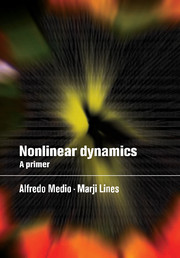Book contents
- Frontmatter
- Contents
- Preface
- 1 Statics and dynamics: some elementary concepts
- 2 Review of linear systems
- 3 Stability of fixed points
- 4 Invariant and attracting sets, periodic and quasiperiodic orbits
- 5 Local bifurcations
- 6 Chaotic sets and chaotic attractors
- 7 Characteristic exponents, fractals, homoclinic orbits
- 8 Transition to chaos
- 9 The ergodic approach
- 10 Deterministic systems and stochastic processes
- Further reading
- Bibliography
- Subject index
6 - Chaotic sets and chaotic attractors
Published online by Cambridge University Press: 14 May 2010
- Frontmatter
- Contents
- Preface
- 1 Statics and dynamics: some elementary concepts
- 2 Review of linear systems
- 3 Stability of fixed points
- 4 Invariant and attracting sets, periodic and quasiperiodic orbits
- 5 Local bifurcations
- 6 Chaotic sets and chaotic attractors
- 7 Characteristic exponents, fractals, homoclinic orbits
- 8 Transition to chaos
- 9 The ergodic approach
- 10 Deterministic systems and stochastic processes
- Further reading
- Bibliography
- Subject index
Summary
Invariant, attracting sets and attractors with a structure more complicated than that of periodic or quasiperiodic sets are called chaotic. Before providing precise mathematical definitions of the properties of chaotic systems, let us first try to describe them in a broad, nonrigorous manner. We say that a discrete- or continuous-time dynamical system is chaotic if its typical orbits are aperiodic, bounded and such that nearby orbits separate fast in time. Chaotic orbits never converge to a stable fixed or periodic point, but exhibit sustained instability, while remaining forever in a bounded region of the state space. They are, as it were, trapped unstable orbits. To give an idea of these properties, in figure 6.1 we plot a few iterations of a chaotic discrete-time map on the interval, with slightly different initial values. The two trajectories remain close for the first few iterations, after which they separate quickly and have thereafter seemingly uncorrelated evolutions. Time series resulting from numerical simulations of such trajectories look random even though they are generated by deterministic systems, that is, systems that do not include any random variables. Also, the statistical analysis of deterministic chaotic series by means of certain linear techniques, such as estimated autocorrelation functions and power spectra, yields results similar to those determined for random series. Both cases are characterised by a rapidly decaying autocorrelation function and a broadband power spectrum.
remark 6.1 Notice that one or another (but not all) of the properties listed above can be found in nonchaotic systems as well.
- Type
- Chapter
- Information
- Nonlinear DynamicsA Primer, pp. 163 - 192Publisher: Cambridge University PressPrint publication year: 2001

